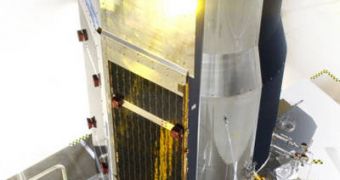For over five and a half years, NASA's Spitzer Space Telescope has been scouting the horizons in search for new and mysterious stellar formations, using instruments running in the near- and far-infrared wavelengths. But, in order for such instruments to be operated, the observatory carrying them needs to be cool enough to detect faint heat signatures, coming from billions of light-years away. The only way that can be achieved is by cooling the telescope itself to almost absolute zero.
And therein lies Spitzer's limitation – it operates all of its three instruments at temperatures of about -456 degrees Fahrenheit (-271 Celsius), less than three degrees warmer than -273 degrees Celsius, or 0 Kelvin (absolute zero). Responsible for keeping this extremely low temperature is the telescope's circulatory system, composed of pipes moving around liquid nitrogen, the ultimate coolant. But the reserves supplying the craft are extremely low and scientists in charge of the mission expect the fuel to run out in the next two to three weeks.
Already, the coolant has far outlived its designated life span. Originally, the amounts of liquid nitrogen that were stored aboard the observatory were thought to be sufficient for about two and a half years of operations, but improved efficiency, and a good use of resources managed to more than double that life span. However, now, reserves that have been already stretched thin, are coming to an end, and Spitzer needs to reinvent itself.
But a lack of nitrogen does not spell destruction for the venerable observatory. “We like to think of Spitzer as being reborn. Spitzer led an amazing life, performing above and beyond its call of duty. Its primary mission might be over, but it will tackle new scientific pursuits, and more breakthroughs are sure to come,” NASA Jet Propulsion Laboratory (JPL) Spitzer Project Manager Robert Wilson said in a press release. The telescope will not be shut down, but it won't be able to operate all of its instruments either, so NASA has figured out a way of mixing the two together.
After the cooling system shuts down, the telescope will warm to -404 degrees Fahrenheit (-242 Celsius), which will no longer allow for the controllers to use its longer wavelength multiband imaging photometer and its infrared spectrograph, the two main instruments in Spitzer. However, the two shortest-wavelength detectors in its infrared array camera will still remain fully operational, and able to peer through the dusty covers inside our galaxy, which regularly block visible light.
“We will do exciting and important science with these two infrared channels. Our new science program takes advantage of what these channels do best. We're focusing on aspects of the cosmos that we still have much to learn about,” JPL expert Michael Werner, the Spitzer project scientist, who has been working on the observatory for the past 30 years, concluded.

 14 DAY TRIAL //
14 DAY TRIAL //